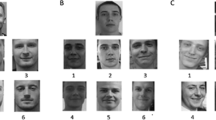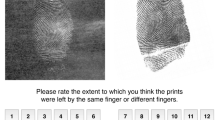Abstract
The digital age has brought with it new and powerful computer-based methods of analyzing heretofore elusive patterns of nonverbal behavior. C-BAS (Meservy 2010) is a computer-assisted behavioral observation tool for identifying and tracking nonverbal behaviors from video. THEME (Magnusson, The hidden structure of interaction: from neurons to culture patterns, IOS Press, Amsterdam, pp 4–22, 2005) is a software program that discovers patterns among discrete events in time-ordered data. Together, these tools enable more precise measurement and analysis of nonverbal behavioral dynamics. Applications to three corpora derived from interpersonal deception experiments reveal unique nonverbal patterns that distinguish deceptive from nondeceptive interactions. The first and second experiments produced serial, hierarchically related patterns of behaviors that differed in length and complexity between truthful and deceptive participants during interviews about a theft and cheating, respectively. The third experiment produced differential patterns by and among group members completing a task. Deceivers were inclined toward strategic initiations and interactional control, whereas suspicious group members adopted a more passive, possibly watchful stance. Discovery of these patterns challenges the prevailing view that nonverbal behaviors are too faint and inconsistent to identify deceptive communication. Results have numerous implications regarding the following: the development of new measurement tools locating significant effects of nonverbal behaviors, support for theory that coherent and repetitive relationships exist within and among interactants’ communication, demonstration of the role of nonverbal behaviors in deceptive communication and the dynamic and strategic nature of deception.








Similar content being viewed by others
References
Agliati, A., Vescovo, A., & Anolli, L. (2006). A new methodological approach to nonverbal behavior analysis in cultural perspective. Behavior Research Methods, 38(3), 364–371.
Allwood, J., Kopp, S., Grammer, K., Ahlsén, E., Oberzaucher, E., & Koppensteiner, M. (2007). The analysis of embodied communicative feedback in multimodal corpora: A prerequisite for behavior simulation. Language Resources and Evaluation, 41(3), 255–272.
Birdwhistell, R. (1970). Kinesics and context: Essays on body motion communication. Philadelphia: University of Pennsylvania Press.
Biros, D. P., Sakamoto, J., George, J. F., Adkins, M., Kruse, J., Burgoon, J.K., & Nunamaker, J. F., Jr. (2005). A quasi-experiment to determine the impact of a computer based deception detection training system: The use of Agent99 Trainer in the U.S. military. Proceedings of the 38th annual Hawaii international conference on system sciences, January 3–6.
Bond, J. C. F., & DePaulo, B. M. (2006). Accuracy of deception judgments. Personality and Social Psychology Review, 10(3), 214–234.
Borrie, A., Jonsson, G. K., & Magnusson, M. S. (2001). Application of T-pattern detection and analysis in sports research. Hidden Temporal Patterns in Interaction, 3, 215–226.
Borrie, A., Jonsson, G. K., & Magnusson, M. S. (2002). Temporal pattern analysis and its applicability in sport: An explanation and exemplar data. Journal of Sports Sciences, 20(10), 845–852.
Brdiczka, O., Su, N. M., & Begole, J. B. (2010). Temporal task footprinting: Identifying routine tasks by their temporal patterns. Paper presented at the Proceedings of the 15th international conference on intelligent user interfaces.
Buller, D. B., & Burgoon, J. K. (1996). Interpersonal deception theory. Communication Theory, 6(3), 203–242.
Burgoon, J. K., & Buller, D. B. (1994). Interpersonal deception: III. Effects of deceit on perceived communication and nonverbal behavior dynamics. Journal of Nonverbal Behavior, 18, 155–184.
Burgoon, J. K., Buller, D. B., Dillman, L., & Walther, J. B. (1995). Interpersonal deception. Human Communication Research, 22(2), 163–196.
Burgoon, J. K., & Dunbar, N. E. (2006). Nonverbal expressions of dominance and power in human relationships. In V. Manusov & M. Patterson (Eds.), The Sage handbook of nonverbal communication. Beverly Hills, CA: Sage.
Burgoon, J. K., George, J. F., Kruse, J., Marett, K., & Adkins, M. A. (in press). Credibility assessment in meetings: Deception. In J. F. Nunamaker, N. Romano, & R. Briggs (Eds.), Advances in MIS: Collaboration science, technologies, processes and applications. Armonk, NY: M.E. Sharpe.
Burgoon, J. K., Guerrero, L. K., & Floyd, K. (2010). Nonverbal communication. Boston: Pearson.
Burgoon, J. K., Hamel, L., & Qin, T. (2012). Predicting veracity from linguistic indicators (pp. 323–328). Presented at Intelligence and Security Informatics Conference (EISIC).
Burgoon, J. K., & Qin, T. (2006). The dynamic nature of deceptive verbal communication. Journal of Language and Social Psychology, 26, 76–96.
Caris-Verhallen, W., Timmermans, L., & van Dulmen, S. (2004). Observation of nurse–patient interaction in oncology: Review of assessment instruments. Patient Education and Counseling, 54(3), 307–320.
Casarrubea, M., Roy, V., Sorbera, F., Magnusson, M., Santangelo, A., Arabo, A., et al. (2013). Temporal structure of the rat’s behavior in elevated plus maze test. Behavioural Brain Research, 237, 290–299.
Castañer, M., Torrents, C., Anguera, M. T., Dinušová, M., & Jonsson, G. K. (2009). Identifying and analyzing motor skill responses in body movement and dance. Behavior Research Methods, 41(3), 857–867.
Chovil, N. (2004). Measuring conversational facial displays. In V. Manusov (Ed.), The sourcebook of nonverbal measures: Going beyond words (pp. 173–188). Hillsdale, NJ: Lawrence Erlbaum Associates.
de Haas, R., Nijdam, A., Westra, T. A., Kas, M. J., & Westenberg, H. G. (2011). Behavioral pattern analysis and dopamine release in quinpirole-induced repetitive behavior in rats. Journal of Psychopharmacology, 25(12), 1712–1719.
de Haas, R., Seddik, A., Oppelaar, H., Westenberg, H. G. M., & Kas, M. J. H. (2012). Marked inbred mouse strain difference in the expression of quinpirole induced compulsive like behavior based on behavioral pattern analysis. European Neuropsychopharmacology, 22(9), 657–663.
DePaulo, B. M., Lindsay, J. J., Malone, B. E., Muhlenbruck, L., Charlton, K., & Cooper, H. (2003). Cues to deception. Psychological Bulletin, 129(1), 74.
Dunbar, N. E., Jensen, M. L., Bessarabova, E., Burgoon, J. K., Bernard, D. R., Harrison, K. J., et al. (2012). Empowered by persuasive deception: The effects of power and deception on dominance, credibility, and decision making. Communication Research.
Duncan, J. S. (1974). On the structure of speaker-auditor interaction during speaking turns. Language in Society, 3(2), 161–180.
Ekman, P., & Friesen, W. V. (1969). Nonverbal leakage and clues to deception. Psychiatry, 32, 88–106.
Exline, R. V., Thibaut, J., Brannan, C., & Gumpert, P. (1970). Visual interaction in relation to Machiavellianism and an unethical act. In R. Christie & F. L. Geis (Eds.), Studies in Machiavellianism (pp. 53–76). New York: Academic Press.
Fuller, C. M., Twitchell, D. P., & Marett, K. (2012). An examination of deception in virtual teams: Effects of deception on task performance, mutuality, and trust. IEEE Transactions on Professional Communication, 55(1), 20–35.
Grammer, K., Fink, B., & Renninger, L. (2002). Dynamic systems and inferential information processing in human communication. Neuroendocrinology Letters, 23(4), 15–22.
Grammer, K., Kruck, K. B., & Magnusson, M. S. (1998). The courtship dance: Patterns of nonverbal synchronization in opposite-sex encounters. Journal of Nonverbal Behavior, 22(1), 3–29.
Hartwig, M., & Bond, C. F, Jr. (2011). Why do lie-catchers fail? A lens model meta-analysis of human lie judgments. Psychological Bulletin, 137(4), 643–659.
Herzing, D. L. (2006). The currency of cognition: Assessing tools, techniques, and media for complex behavioral analysis. Aquatic Mammals, 32(4), 544.
Hirschenhauser, K., Frigerio, D., Grammer, K., & Magnusson, M. S. (2002). Monthly patterns of testosterone and behavior in prospective fathers. Hormones and Behavior, 42(2), 172–181.
Holler, J., & Beattie, G. (2003). Pragmatic aspects of representational gestures. Gesture, 3, 127–154.
Jonsson, G. K., Anguera, M. T., Blanco-Villaseñor, Á., Luis Losada, J., Hernández-Mendo, A., Ardá, T., et al. (2006). Hidden patterns of play interaction in soccer using SOF-CODER. Behavior Research Methods, 38(3), 372–381.
Kemp, A. S., Fillmore, P. T., Lenjavi, M. R., Lyon, M., Chicz-DeMet, A., Touchette, P. E., et al. (2008). Temporal patterns of self-injurious behavior correlate with stress hormone levels in the developmentally disabled. Psychiatry Research, 157(1), 181–189.
Kerepesi, A., Kubinyi, E., Jonsson, G., Magnusson, M., & Miklósi, A. (2006). Behavioural comparison of human–animal (dog) and human–robot (AIBO) interactions. Behavioural Processes, 73(1), 92–99.
Levine, T. R. (2007). MSU trivia game interviews. Unpublished video tapes. Michigan State University. East Lansing.
Magnusson, M. S. (2005). Understanding social interaction: Discovering hidden structure with model and algorithms. In L. Anolli, J. Duncan, & M. S. Magnusson (Eds.), The hidden structure of interaction: From neurons to culture patterns (pp. 4–22). Amsterdam: IOS Press.
Magnusson, M. S. (2006). Structure and communication in interactions. In G. Riva, M. T. Anguera, B. K. Wiederhold, & F. Mantovani (Eds.), Communication to presence: Cognition, emotions and culture towards the ultimate communicative experience (pp. 127–145). Amsterdam: IOS Press.
Marett, L. K., & George, J. F. (2004). Deception in the case of one sender and multiple receivers. Group Decision and Negotiation, 13(1), 29–44.
Martaresche, M., Le Fur, C., Magnusson, M., Faure, J., & Picard, M. (2000). Time structure of behavioral patterns related to feed pecking in chicks. Physiology & Behavior, 70(5), 443–451.
Mazzi, M. A., Piccolo, L. D., & Zimmermann, C. (2003). Event-based categorical sequential analyses of the medical interview: A review. Epidemiologia e Psichiatria Sociale, 12, 81–85.
Meservy, T. O. (2010). CBAS 2.0: Center for identification technology research.
Newman, M. L., Pennebaker, J. W., Berry, D. S., & Richards, J. M. (2003). Lying words: Predicting deception from linguistic styles. Personality and Social Psychology Bulletin, 29(5), 665–675.
Noldus Observer. (2013): Noldus information technology.
Ramirez, A., Walther, J. B., Burgoon, J. K., & Sunnafrank, M. (2002). Information-seeking strategies, uncertainty, and computer-mediated communication: Toward a conceptual model. Human Communication Research, 28(2), 213–228.
Sporer, S. L., & Schwandt, B. (2007). Moderators of nonverbal indicators of deception: A meta-analytic synthesis. Psychology, Public Policy, and Law, 13(1), 1.
Stachowski, A. A., Kaplan, S. A., & Waller, M. J. (2009). The benefits of flexible team interaction during crises. Journal of Applied Psychology, 94(6), 1536–1543.
Vrij, A., Akehurst, L., Soukara, S., & Bull, R. (2004a). Detecting deceit via analyses of verbal and nonverbal behavior in children and adults. Human Communication Research, 30(1), 8–41.
Vrij, A., Evans, H., Akehurst, L., & Mann, S. (2004b). Rapid judgements in assessing verbal and nonverbal cues: Their potential for deception researchers and lie detection. Applied Cognitive Psychology, 18(3), 283–296.
Wedl, M., Bauer, B., Gracey, D., Grabmayer, C., Spielauer, E., Day, J., et al. (2011). Factors influencing the temporal patterns of dyadic behaviours and interactions between domestic cats and their owners. Behavioural Processes, 86(1), 58–67.
Zhou, L., Burgoon, J. K., Nunamaker, J. F., & Twitchell, D. P. (2004). Automating linguistics-based cues for detecting deception in text-based asynchronous computer-mediated communication. Group Decision and Negotiation, 13(1), 81–106.
Acknowledgments
The authors gratefully acknowledge the considerable advice and consultation by Dr. Magnus Magnusson, University of Iceland, who developed THEME and expanded its features for the benefit of this research project. Portions of this research were supported by funding from the U. S. Air Force Office of Scientific Research under the U. S. Department of Defense University Research Initiative (Grant #F49620-01-1-0394; PI: Burgoon) and the National Science Foundation (Grant # 0725895, Award IIP-1068026; PI: Burgoon). The views, opinions, and/or findings in this report are those of the authors and should not be construed as an official Department of Defense or National Science Foundation position, policy, or decision.
Conflict of interest
The authors declare that they have no conflict of interest.
Author information
Authors and Affiliations
Corresponding author
Rights and permissions
About this article
Cite this article
Burgoon, J.K., Proudfoot, J.G., Schuetzler, R. et al. Patterns of Nonverbal Behavior Associated with Truth and Deception: Illustrations from Three Experiments. J Nonverbal Behav 38, 325–354 (2014). https://doi.org/10.1007/s10919-014-0181-5
Published:
Issue Date:
DOI: https://doi.org/10.1007/s10919-014-0181-5




